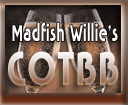Geek Beer 1.0
Duke Nukem aka Physics Geek - Madfish Willie's Official Brewmeister has oncorked his latest home brew creation upon Madfish Willie.
I recieved two bottles of Geek Beer last Wednesday. Put em in the frig to get nice and cold and wait for the sediment to settle. Ready to unleash on society on Friday night.
Now, I'm not the type of of guy who will tell you the flavor was bitter nutty with a fruity aftertaste and that you should let it breath a bit. It's not fucking wine... it's beer dammmit! I will tell you, however, that it was a full bodied beer with a nice taste. Better than most of those brew pub creations. Plus, I got a pretty good buzz started after finishing the two big bottles.
I think I may need more samples to really give you the nutty, fruity, breathy, review.
Good Stuff Maynard! Thanks Mr Geek!!!
What they said »Official Brewmeister News
Duke Nukem, better known as Physics Geek, Madfish Willie's Official Brewmeister, has good news for you beer connoisseurs out there.
The beer is in the secondary and will be bottled next Sunday. It'll be ready for drinking/shipping about 10 days after that. Time to belly up to the bar.
Go over to the Geeks place and ask him whassup wid da brew?
What they said »Two More Beers, Please
Linda at Civilization Calls, a Corner of the Bar Babe (who has not posted her logo by the way) has blogrolled a couple of new bloggers. I found a link over to the spaceman's blog Spacecraft. He has a archive category for Beer. So, natually I clicked through to see what he's up to with space beer. [In space, there is no beer!]
He has a post that offers the phrase: Two More Beers, Please in different languages. Here are some examples:
Noch zwoa! (Austrian, western part)
Twee meer pils, alstublieft (Dutch)
Veel kaks őlut, palun! (Estonian)
Viela kaksi olutta kiitos (Finnish)
Zwei weitere Biere, bitte! (German)
Noch zwei Bier, bitte! (German)
Meg ket sort kerek (Hungarian)
Beeru wo mou nihon, onegaishimasu (Japanese)
Yehshche dvah pihva, prosheh (Polish)
Mido yidi biere didi (Pulaar)
Inca doua beri, va rog (Romanian)
Menya, pashalyaesta, dva pevo (Russian)
Dos cervezas mas, por favor (Spanish)
Dve piva, prosim (forgot. Serbian?)
One commenter also posts the natural follow up question: "żDónde está el bańo?"
What they said »Beer Prayer
>The Beer Prayer comes to Madfish Willie's via SilverBlue. Before we pour the first beer and start the Happy Hour Party every day, we pause for a moment of peace and recite this prayer:
Our Lager, which art in barrels,Cheers! What they said »
Hallowed be thy drink.
Thy will be drunk (I will be drunk),
At home as it is in the Pub.
Give us this day our foamy head,
And forgive us our spillages,
As we forgive those who spill against us.
And lead us not into incarceration,
But deliver us from hangover.
For thine is the Beer, the Bitter and the Lager,
For ever and ever.
Barmen!
Drinking Beer Makes Your Smarter!
In Madfish Willie's never-ending quest to bring you good news, he often stumbles across something so mind-numbingly obvious, that he hits himself upside the head and says: "Damn, I knew that!"
In this article gleemed from Forbes Magazine, he finds just such news:
A herd of buffalo can only move as fast as the slowest buffalo, and when the herd is hunted, it is the slowest and weakest ones at the back that are killed first. This natural selection is good for the herd as a whole, because the general speed and health of the whole is maintained or even improved by the regular culling of the weakest members.So, there you go - evidence that drinking helps your intelligence!In much the same way, the human brain can operate only as fast as the slowest brain cells through which the electrical signals pass. Recent epidemiological studies have shown that while excessive intake of alcohol kills off brain cells, it attacks the slowest and weakest brain cells first.
Thus, regular consumption of beer, wine etc., helps eliminate the weaker cells, constantly making the brain a faster and more efficient machine. The result of this in-depth study verifies and validates the causal link between all-weekend parties and job related performance. It also explains why, after a few short years of leaving a university and getting married, most professionals cannot keep up with the performance of the new graduates. Only those few that stick to the strict regimen of voracious alcoholic consumption can maintain the intellectual levels that they achieve during their college years.
So, this is a call to arms. As our country is losing its technological edge, we cannot shudder in our homes. Get back into the bars. Quaff that pint. Your company and country need you to be at your peak, and you shouldn't deny yourself the career that you could have. Take life by the bottle and be all that you can be. Forward this to all of your friends, acquaintances and co-workers that may be in danger of losing their edge.
Cheers!
What they said »Geek Beer
>Madfish Willie's tries cater to a broad range of tastes and clientele. To that end, I would like to introduce a new line of beers being brewed up by Madfish Willie's Official Brewmeister: Physics Geek. This particular line of beer will be for the Geeks among us who truly deserve their own special brand of brewski's! Here's what Physics Geek has in the oven:
DOS Beer:
Requires you to use your own can opener, and requires you to read the directions carefully before opening the can. Originally only came in an 8-oz can, but now comes in a 16-oz can. However, the can is divided into 8 compartments of 2-oz each, which have to be accessed separately. Soon to be discontinued, although a lot of people are going to keep drinking it after it's no longer available.
MAC Beer:
At first, came only in a 16-oz can, but now comes in a 32-oz can. Considered by many to be a "light" beer. All the cans look identical. When you take one from the fridge, it opens itself. The ingredients list is not on the can. If you call to ask about the ingredients, you are told that "you don't need to know." A notice on the side reminds you to drag your empties to the wastebin.
Windows 95 Beer:
The world's most popular beer. Comes in a 16-oz can that looks a lot like Mac Beer's. Requires that you already own a DOS Beer. Claims that it allows you to drink several DOS Beers simultaneously, but in reality you can only drink a few of them, very slowly, especially slowly if you are drinking the Windows Beer at the same time. Sometimes, for no apparent reason, a can of Windows Beer will explode when you open it.
Windows 98 Beer:
See Windows 95 beer above. About the same but Windows 98 beer creates less gas and makes you crash less.
Windows 2000 Beer:
A new beer on the market. A lot of people have taste tested it and claim it's wonderful. The can looks like Mac and OS/2 Beer's can, but tastes like Windows 95/98 Beer. It comes in 32-oz cans, but when you look inside, the cans only have 16-oz of beer in them. Most people will probably keep drinking Windows 95/98 Beer until their friends try Windows 2000 Beer and say they like it. The ingredients list, when you look at the small print, has some of the same ingredients that come in DOS and Mac Beer, even though the manufacturer claims that this is an entirely new brew.
Windows NT Beer:
Comes in 32-oz cans, but you can only buy it by the truckload. This causes most people to go out and buy bigger refrigerators. The can looks just like Windows 95 Beer's, but the company promises to change the can to look like Windows 2000 Beer's, after Windows 2000 Beer starts shipping well. Touted as an "industrial strength" beer, and suggested only for use in bars.
Unix Beer:
Comes in several different brands, in cans ranging from 8-oz to 64-oz. Drinkers on Unix Beer display fierce brand loyalty, even though they claim that all the different brands taste almost identical. Sometimes the pop-tops break off when you try to open them, so you have to have your own can opener around for these occasions, in which case you either need a complete set of instructions, or a friend who has been drinking Unix Beer for several years...
AmigaOS Beer:
The company has gone out of business, but their recipe has been picked up by some weird German company, so now this beer will be an import. This beer never really sold very well, because the original manufacturer didn't understand marketing. Like Unix Beer, AmigaDOS Beer fans are an extremely loyal and loud group. It originally came in a 16-oz can, but now comes in 32-oz cans too. When this can was originally introduced, it appeared flashy and colourful, but the design hasn't changed much over the years, so it appears dated now. Critics of this beer claim that it is only meant for watching TV anyway.
Let's all raise a cold draught beer to the Physics Geek for these fine brews!
Cheers!
What they said »Official Brewmeister
We are proud to announce the addition of The Physics Geek as Madfish Willie's Official Brewmeister.
Mmm... Beer! [drool runs out the side of mouth]
In his first annoucement since taking office, The Physics Geek lays out the brewing schedule for the first batch of Madfish Beer.
The beer in question will be a strong (based on past experience) dunkel weizen. I'm still convincing the chief that I need to brew another batch. She's sympathetic to the needs of my hobby but she hates the smell of boiling wort. I'm looking to brew the weekend of November 8th and bottling the 22nd. Should be ready to drink by mid-December.
We look forward to this very special batch of handcrafted beverage.
Just in time for the holiday drinking festivities!
Update: We need an Official Name for this batch of beer!
Cheers!
What they said »The History of Beer - Part IV
The history of beer is a five-part series documenting... well, the history of beer.
1. The History of Beer
2. The Story of Beer
3. The Brewing of Beer
4. Styles of Beer
5. Beer Today
Styles of Beer
The American Homebrewer's Association recognizes seventy styles of beer. Here is a description of the most common styles:
- Dark beer: Beer becomes darker when the barley is kilned for a longer period of time. This also creates richer, deeper flavors from the roasted grain.
- Lager: Two different types of yeast can be used to create alcohol. Yeast that ferments slowly at a low temperature creates a smoother, more mellow beer.
- Ale: The other type of yeast, which ferments more rapidly and at a higher temperature, results in a more aromatic and fruity product.
- Amber: Malty, hoppy beers with a rich golden color.
- Bitter: A British style, highly hopped for a more dry and aromatic beer, pale in color but strong in alcohol content.
- Fruit Beer: Fruit may be added either during the primary fermentation or later. Usually made with berries, although other fruits can be used.
- India Pale Ale: The name is often shortened to IPA. This ale was originally brewed in England for export to India. The large quantities of hops added were intended as a preservative and to mask potential off-flavors that might develop during the long voyage.
- Pilsner: This is the term for the classic lager originally developed in Czechoslovakia, a pale, golden-hued, light beer after which many mass-produced American beers are modeled.
- Porter: Very bitter, very dark, this beer was developed in England as a "nourishing" drink for manual laborers such as porters.
- Stout: Very dark and heavy, with roasted unmalted barley and, often, caramel malt or sugar. Invented by Guinness as a variation on traditional porter.
- Wheat beer (Weizen): Malted wheat, in addition to barley, is used for this German style beer. Hefeweizen is a variation.
Tomorrow: Beer Today
Cheers!
The History of Beer - Part III
The history of beer is a five-part series documenting... well, the history of beer.
1. The History of Beer
2. The Story of Beer
3. The Brewing of Beer
4. Styles of Beer
5. Beer Today
The Brewing of Beer
Almost all beer contains only four ingredients: barley, water, hops, and yeast.
Different styles of beer are created by variations in the brewing process, which consists of four stages.
The first ingredient to come into play is barley, which is grain (or in other words, a seed). The seeds are soaked and allowed to begin their development into plants. Enzymes are released that will break down the proteins and starches in each grain into simple sugars meant to nourish the baby plant. However, once this process has begun, the barley is cooked in a kiln, arresting the growth process while the enzymes are at their peak of production. This is called malting.
In the mashing stage, the grain is actually transformed into sugar. The grains are crushed and then soaked in water. Proteins are broken down; these will eventually give the beer its body. Starches are broken down into simple sugars that will nourish the yeast. Complex sugars remain to give the beer its malty taste. The mash is heated and strained to yield a substance called wort.
Next, the wort is brought to a boil and the flowers of the female hop plant are added. Bitter resins and aromatic hop oils are released.
The variety of hop, the amount added, and the point or points in the boil at which they are added all contribute to the flavor of the beer. They add bitterness when added early to the boil, flavor if added in the middle, and aroma when added at the end. Then the beer is cooled and yeast is added and allowed to consume most or all of the sugars in the wort. This is the fermentation process, in which alcohol is produced. The beer is separated from the yeast (racked) and then aged and carbonated by conducting a second fermentation in a closed container, or by adding carbon dioxide artificially.
Tomorrow: Styles Of Beer
Cheers!
History of Ber - Part II
The history of beer is a five-part series documenting... well, the history of beer.
1. The History of Beer
2. The Story of Beer
3. The Brewing of Beer
4. Styles of Beer
5. Beer Today

The Story of Beer
Beer is one of the oldest products of civilization, and may even have been a stepping stone to the invention of leavened bread.
Beer's Beginnings
Historians believe that the ancient Mesopotamians and Sumerians were brewing as early as 10,000 BC.
Although the product would have been somewhat different from today's bottled varieties, it would be recognizable.
The ancient Egyptians and Chinese brewed beer, as did pre-Columbian civilizations in the Americas, who used corn instead of barley.
In the middle ages, European monks were the guardians of literature and science, as well as the art of beer making. They refined the process to near perfection and institutionalized the use of hops as a flavoring and preservative. However, it wasn't until Louis Pasteur came along that a final, important development was made. Until that time, brewers had to depend on wild, airborne yeast for fermentation. By establishing that yeast is a living microorganism, Pasteur opened the gates for accurately controlling the conversion of sugar to alcohol.
While grapes grow well in warm climates, barley grows better in cooler climes. This is how the northern countries of Germany and England became famous for their beers. This production was taken very seriously, as it was in the New World, where beer was a major component of the Pilgrim's diet.
Beer in America
Beer was of major concern for revolutionary thinkers like Thomas Jefferson, who quickly passed legislation to create a healthy beer industry in the new United States.
Everything went swimmingly until the dark day in 1920 when Prohibition took effect. Many breweries went out of business or switched to the production of soda pop. Of course, not everyone stopped drinking, but gangster-controlled operations were not known for high-quality products.
Late in 1933, Congress passed the 21st Amendment to the Constitution which repealed the unpopular law. However, the new breeds of American beer that came after World War II were generally mass-produced and very bland. Jimmy Carter legalized home brewing, ushering in the age of microbreweries, beer hobbyists, and beer snobs.
Tomorrow: How Beer Is Made
Cheers!
History of Beer
The history of beer is a five-part series documenting... well, the history of beer.
1. The History of Beer
2. The Story of Beer
3. The Brewing of Beer
4. Styles of Beer
5. Beer Today
The History of Beer
Beer is proof that God loves us and wants us to be happy. --Benjamin Franklin
Beer is as old as civilization itself. One of the most common and popular of beverages, it is made in every corner of the world. It has a long and fascinating history, from ancient Egypt to medieval monks, to (for a time) being outlawed by the U.S. Constitution. It has been part of the daily ration for people whose lives have been long and hard, as well as the symbol of celebration, recreation, and relaxation. The local tavern has been a refuge and social universe to many.
The simple combination of barley, water, hops, and yeast produces many different styles of beer. The process has several steps, and although it is simple enough that it can be done at home with the right equipment, many people would consider brewing an art.
Beer types range from a pale, sparkling yellow to dark, rich reddish-brown. There is a place and time for each, from tossing back a cheap cold lager on a summer afternoon to sipping a sweet, syrupy Christmas brew on a cold winter night. Beer generates a sense of well-being and enhances conversation. [ed. Yeah, but what if your are an asshole?]
Although ancient, the custom of beer drinking is by no means in danger of extinction. The recent explosion of microbrews has created a new generation of beer connoisseurs, while the less sophisticated will no doubt continue to love it blindly but passionately.
Tomorrow: The Story Of Beer
Cheers!











